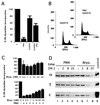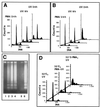Concerted regulation of wild-type p53 nuclear accumulation and activation by S100B and calcium-dependent protein kinase C
- PMID: 10490652
- PMCID: PMC84710
- DOI: 10.1128/MCB.19.10.7168
Concerted regulation of wild-type p53 nuclear accumulation and activation by S100B and calcium-dependent protein kinase C
Abstract
The calcium ionophore ionomycin cooperates with the S100B protein to rescue a p53-dependent G(1) checkpoint control in S100B-expressing mouse embryo fibroblasts and rat embryo fibroblasts (REF cells) which express the temperature-sensitive p53Val135 mutant (C. Scotto, J. C. Deloulme, D. Rousseau, E. Chambaz, and J. Baudier, Mol. Cell. Biol. 18:4272-4281, 1998). We investigated in this study the contributions of S100B and calcium-dependent PKC (cPKC) signalling pathways to the activation of wild-type p53. We first confirmed that S100B expression in mouse embryo fibroblasts enhanced specific nuclear accumulation of wild-type p53. We next demonstrated that wild-type p53 nuclear translocation and accumulation is dependent on cPKC activity. Mutation of the five putative cPKC phosphorylation sites on murine p53 into alanine or aspartic residues had no significant effect on p53 nuclear localization, suggesting that the cPKC effect on p53 nuclear translocation is indirect. A concerted regulation by S100B and cPKC of wild-type p53 nuclear translocation and activation was confirmed with REF cells expressing S100B (S100B-REF cells) overexpressing the temperature-sensitive p53Val135 mutant. Stimulation of S100B-REF cells with the PKC activator phorbol ester phorbol myristate acetate (PMA) promoted specific nuclear translocation of the wild-type p53Val135 species in cells positioned in early G(1) phase of the cell cycle. PMA also substituted for ionomycin in the mediating of p53-dependent G(1) arrest at the nonpermissive temperature (37.5 degrees C). PMA-dependent growth arrest was linked to the cell apoptosis response to UV irradiation. In contrast, growth arrest mediated by a temperature shift to 32 degrees C protected S100B-REF cells from apoptosis. Our results suggest a model in which calcium signalling, linked with cPKC activation, cooperates with S100B to promote wild-type p53 nuclear translocation in early G(1) phase and activation of a p53-dependent G(1) checkpoint control.
Figures











Similar articles
-
Calcium and S100B regulation of p53-dependent cell growth arrest and apoptosis.Mol Cell Biol. 1998 Jul;18(7):4272-81. doi: 10.1128/MCB.18.7.4272. Mol Cell Biol. 1998. PMID: 9632811 Free PMC article.
-
The protein kinase C activator, phorbol ester, cooperates with the wild-type p53 species of Ras-transformed embryo fibroblasts growth arrest.J Biol Chem. 1994 Nov 25;269(47):29579-87. J Biol Chem. 1994. PMID: 7961944
-
Calcium-dependent interaction of S100B with the C-terminal domain of the tumor suppressor p53.J Biol Chem. 1999 Apr 9;274(15):10539-44. doi: 10.1074/jbc.274.15.10539. J Biol Chem. 1999. PMID: 10187847
-
Design of Inhibitors for S100B.Curr Top Med Chem. 2005;5(12):1093-108. doi: 10.2174/156802605774370865. Curr Top Med Chem. 2005. PMID: 16248785 Review.
-
A search for inhibitors of S100B, a member of the S100 family of calcium-binding proteins.Mini Rev Med Chem. 2007 Jun;7(6):609-16. doi: 10.2174/138955707780859422. Mini Rev Med Chem. 2007. PMID: 17584159 Review.
Cited by
-
Theoretical study on binding of S100B protein.J Mol Model. 2007 Nov;13(11):1123-31. doi: 10.1007/s00894-007-0231-6. Epub 2007 Aug 23. J Mol Model. 2007. PMID: 17713798
-
Resistance of MLL-AFF1-positive acute lymphoblastic leukemia to tumor necrosis factor-alpha is mediated by S100A6 upregulation.Blood Cancer J. 2011 Nov;1(11):e38. doi: 10.1038/bcj.2011.37. Epub 2011 Nov 4. Blood Cancer J. 2011. PMID: 22829076 Free PMC article.
-
Structure-Based Discovery of a Novel Pentamidine-Related Inhibitor of the Calcium-Binding Protein S100B.ACS Med Chem Lett. 2012 Dec 13;3(12):975-979. doi: 10.1021/ml300166s. Epub 2012 Sep 25. ACS Med Chem Lett. 2012. PMID: 23264854 Free PMC article.
-
The p57 CDKi integrates stress signals into cell-cycle progression to promote cell survival upon stress.EMBO J. 2012 Jun 29;31(13):2952-64. doi: 10.1038/emboj.2012.122. Epub 2012 May 8. EMBO J. 2012. PMID: 22569127 Free PMC article.
-
S100B protein in tissue development, repair and regeneration.World J Biol Chem. 2013 Feb 26;4(1):1-12. doi: 10.4331/wjbc.v4.i1.1. World J Biol Chem. 2013. PMID: 23580916 Free PMC article.
References
-
- Bates S, Vousden K. p53 in signalling checkpoint arrest or apoptosis. Curr Opin Genet Dev. 1996;6:12–19. - PubMed
-
- Baudier J, Glasser N, Gérard D. Ions binding to S100 protein. Calcium and zinc-binding properties of bovine brain S100αα, S100a (αβ), and S100B (ββ) protein: Zn2+ regulates Ca2+ binding on S100B protein. J Biol Chem. 1986;261:8192–8203. - PubMed
-
- Baudier J, Bergeret E, Bertacchi N, Weintraub H, Gagnon J, Garin J. Interactions of myogenic bHLH transcription factors with calcium-binding calmodulin and S100a (αα) proteins. Biochemistry. 1995;34:7834–7846. - PubMed
Publication types
MeSH terms
Substances
LinkOut - more resources
Full Text Sources
Other Literature Sources
Research Materials
Miscellaneous
